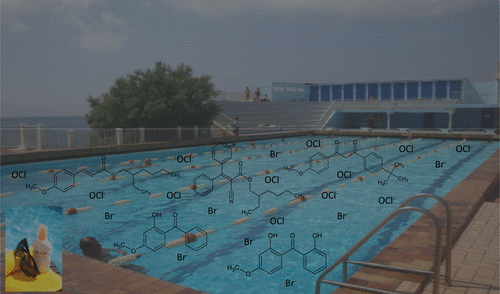当前位置:
X-MOL 学术
›
Environ. Sci. Technol.
›
论文详情
Our official English website, www.x-mol.net, welcomes your feedback! (Note: you will need to create a separate account there.)
Degradation of Organic UV filters in Chlorinated Seawater Swimming Pools: Transformation Pathways and Bromoform Formation
Environmental Science & Technology ( IF 11.4 ) Pub Date : 2017-11-16 00:00:00 , DOI: 10.1021/acs.est.7b02624 Tarek Manasfi 1 , Bruno Coulomb 1 , Sylvain Ravier 1 , Jean-Luc Boudenne 1
Environmental Science & Technology ( IF 11.4 ) Pub Date : 2017-11-16 00:00:00 , DOI: 10.1021/acs.est.7b02624 Tarek Manasfi 1 , Bruno Coulomb 1 , Sylvain Ravier 1 , Jean-Luc Boudenne 1
Affiliation

|
Organic ultraviolet (UV) filters are used in sunscreens and other personal-care products to protect against harmful effects of exposure to UV solar radiation. Little is known about the fate of UV filters in seawater swimming pools disinfected with chlorine. The present study investigated the occurrence and fate of five commonly used organic UV filters, namely dioxybenzone, oxybenzone, avobenzone, 2-ethylhexyl-4-methoxycinnamate, and octocrylene, in chlorinated seawater swimming pools. Pool samples were collected to monitor the variation of UV filter concentrations during pool opening hours. Furthermore, laboratory-controlled chlorination experiments were conducted in seawater spiked with UV filters to investigate the reactivity of UV filters. Extracts of chlorination reaction samples were analyzed using high-resolution mass spectrometry and electron-capture detection to identify the potentially formed byproducts. In the collected pool samples, all the UV filters except dioxybenzone were detected. Chlorination reactions showed that only octocrylene was stable in chlorinated seawater. The four reactive UV filters generated brominated transformation products and disinfection byproducts. This formation of brominated products resulted from reactions between the reactive UV filters and bromine, which is formed rapidly when chlorine is added to seawater. Based on the identified byproducts, the transformation pathways of the reactive UV filters were proposed for the first time. Bromoform was generated by all the reactive UV filters at different yields. Bromal hydrate was also detected as one of the byproducts generated by oxybenzone and dioxybenzone.
中文翻译:

氯化海水游泳池中有机紫外线过滤剂的降解:转化途径和溴仿形成
有机紫外线(UV)过滤器用于防晒霜和其他个人护理产品中,以防止暴露于紫外线太阳辐射下的有害影响。人们对用氯消毒的海水游泳池中的紫外线过滤器的命运知之甚少。本研究调查了五种常用的有机紫外线过滤剂在氯化海水游泳池中的发生和去向,即二氧苯甲酮,氧苯甲酮,阿伏苯宗,2-乙基己基-4-甲氧基肉桂酸酯和辛二烯。收集池样本以监测池开放时间期间紫外线过滤剂浓度的变化。此外,在加有紫外线滤光片的海水中进行了实验室控制的氯化实验,以研究紫外线滤光片的反应性。使用高分辨率质谱和电子捕获检测法分析了氯化反应样品的提取物,以鉴定可能形成的副产物。在收集的样品池中,检测到除二氧苯并ne烯外的所有紫外线过滤剂。氯化反应表明,在氯化海水中只有八甲苯是稳定的。四个反应性紫外线过滤器产生溴化转化产物和消毒副产物。溴化产物的形成是由于反应性紫外线滤光片与溴之间的反应所致,当向海水中添加氯时,溴会迅速形成。基于鉴定出的副产物,首次提出了反应性紫外线滤光片的转化途径。所有反应性紫外线滤光片均以不同的产率生成溴仿。
更新日期:2017-11-16
中文翻译:

氯化海水游泳池中有机紫外线过滤剂的降解:转化途径和溴仿形成
有机紫外线(UV)过滤器用于防晒霜和其他个人护理产品中,以防止暴露于紫外线太阳辐射下的有害影响。人们对用氯消毒的海水游泳池中的紫外线过滤器的命运知之甚少。本研究调查了五种常用的有机紫外线过滤剂在氯化海水游泳池中的发生和去向,即二氧苯甲酮,氧苯甲酮,阿伏苯宗,2-乙基己基-4-甲氧基肉桂酸酯和辛二烯。收集池样本以监测池开放时间期间紫外线过滤剂浓度的变化。此外,在加有紫外线滤光片的海水中进行了实验室控制的氯化实验,以研究紫外线滤光片的反应性。使用高分辨率质谱和电子捕获检测法分析了氯化反应样品的提取物,以鉴定可能形成的副产物。在收集的样品池中,检测到除二氧苯并ne烯外的所有紫外线过滤剂。氯化反应表明,在氯化海水中只有八甲苯是稳定的。四个反应性紫外线过滤器产生溴化转化产物和消毒副产物。溴化产物的形成是由于反应性紫外线滤光片与溴之间的反应所致,当向海水中添加氯时,溴会迅速形成。基于鉴定出的副产物,首次提出了反应性紫外线滤光片的转化途径。所有反应性紫外线滤光片均以不同的产率生成溴仿。



























 京公网安备 11010802027423号
京公网安备 11010802027423号